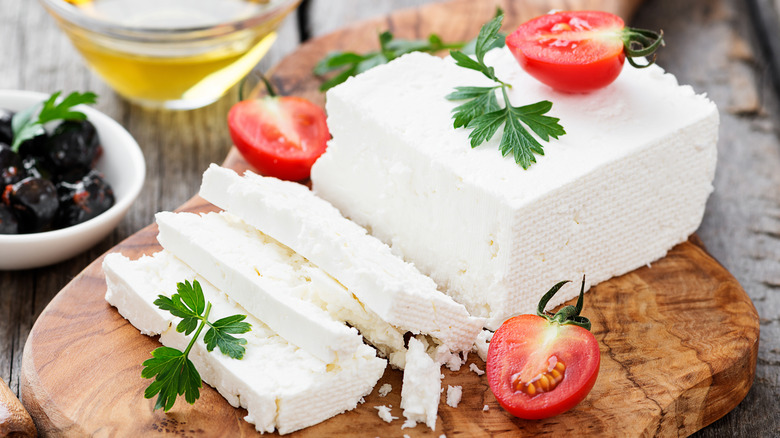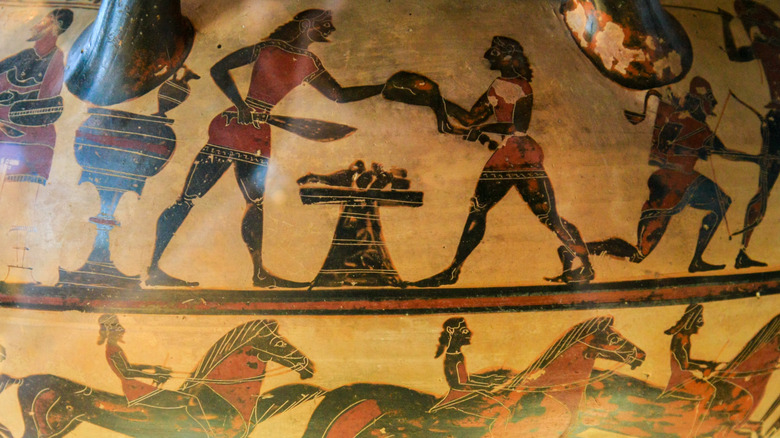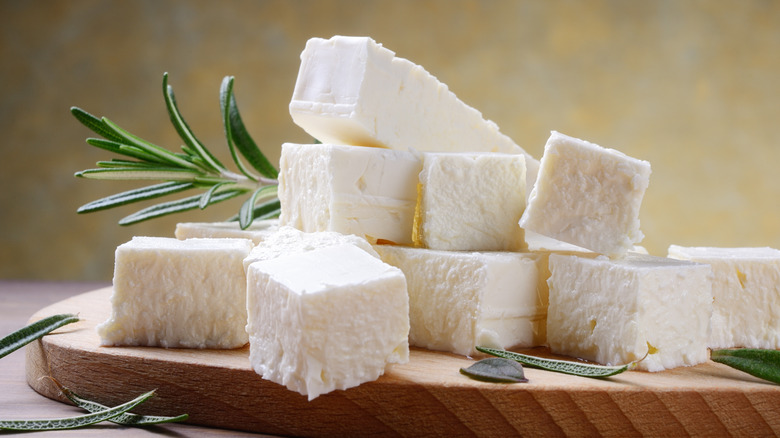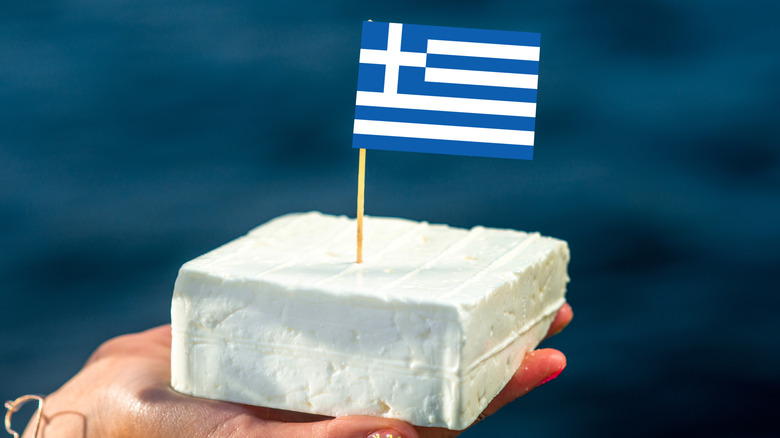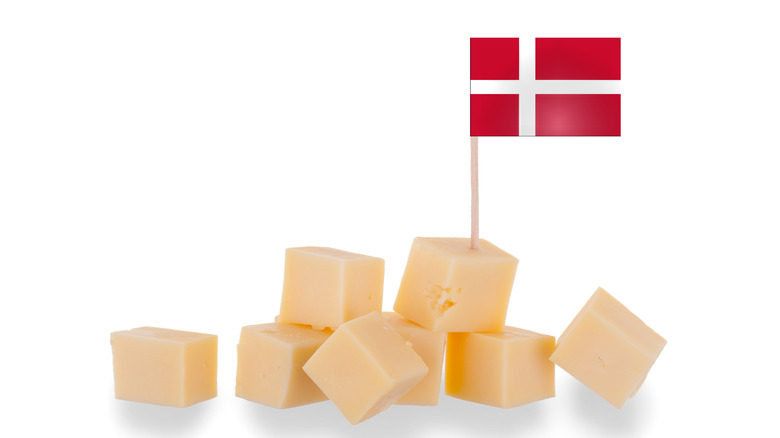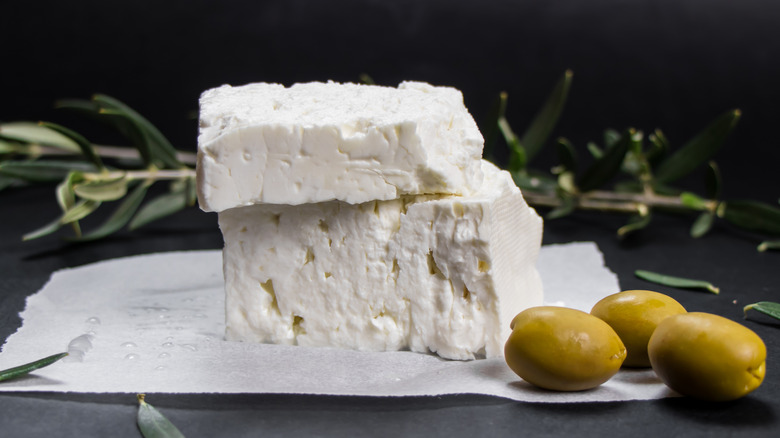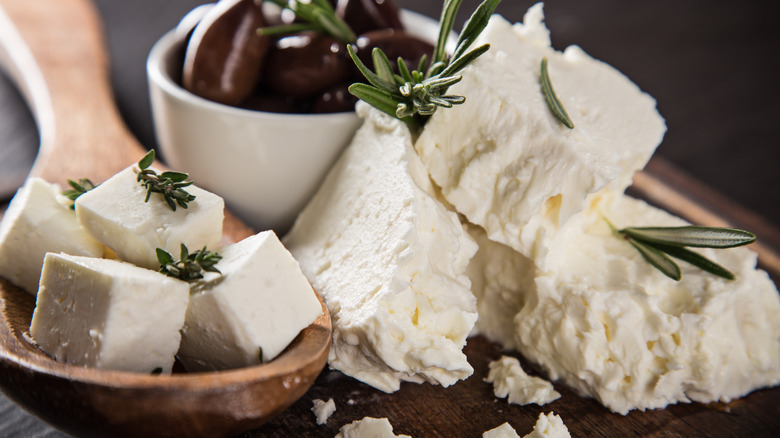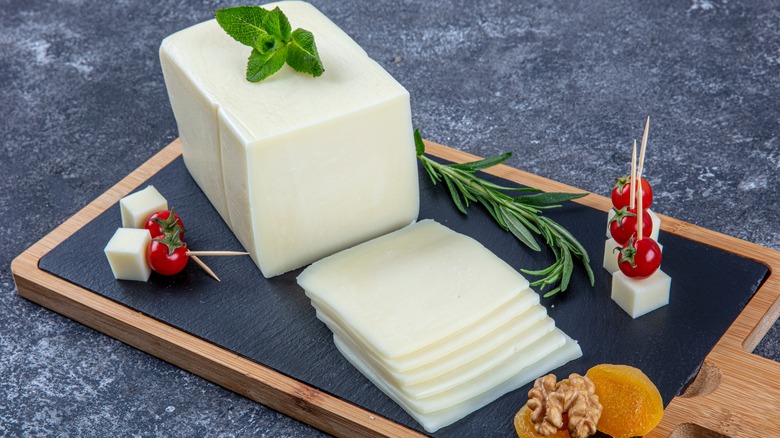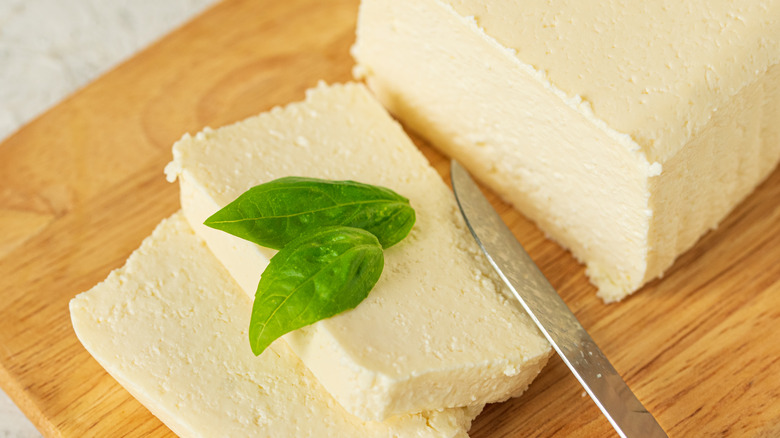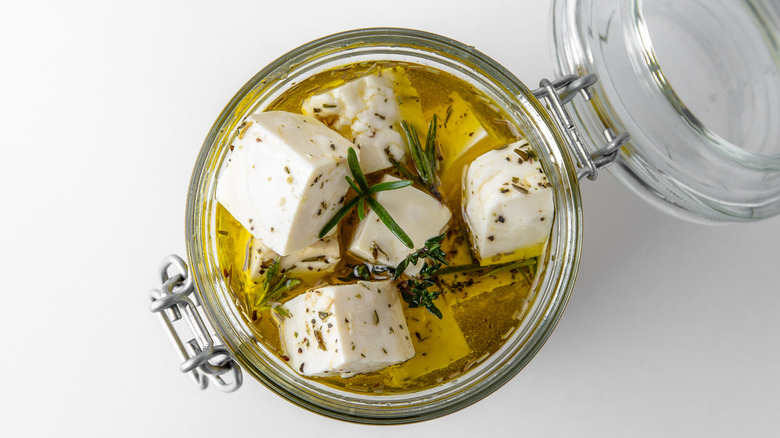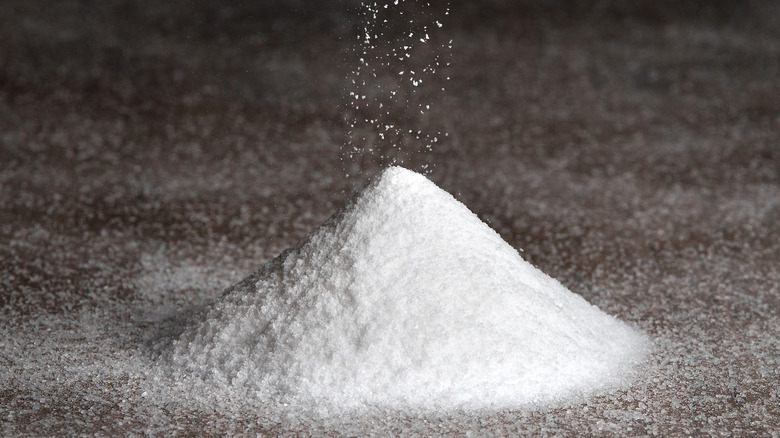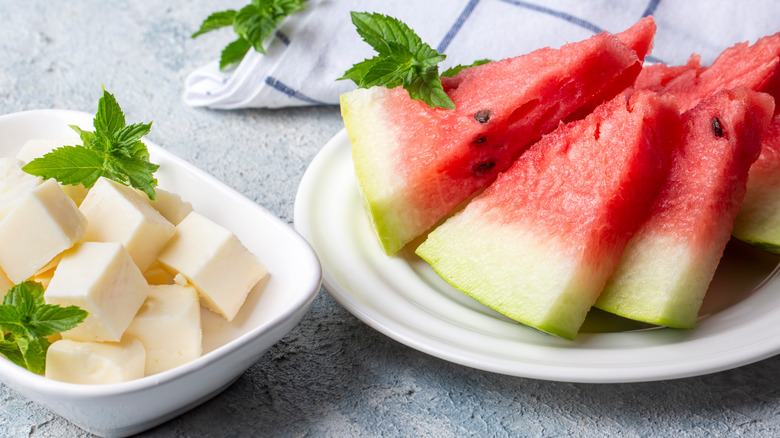The Untold Truth Of Feta Cheese
Feta cheese is a delicious, crumbly-yet-sliceable cheese that is commonly served alongside kalamata olives, pita bread, and hummus. It's not unheard of to find it tossed in a leafy green salad, or even mixed in with scrambled eggs. Nowadays, you can even find feta cheese added into pasta dishes and sauces, or even as a welcome addition to a hot and cheesy pizza.
You might think that feta cheese is just another everyday food item with a typical "born out of necessity" backstory. Nothing more, nothing less. On the contrary, this cheese has a history of epic and godlike proportions, and is so delectably famous that countries are fighting for the right to claim it as their own. You heard right: This rather unique cheese has sparked so much controversy that it's been taken to court. (The cheese stands alone!)
Just like its dairy counterparts, feta cheese can be found in a few different variations, but 100% true, legit feta can only call one country home (though the origins of its name might suggest otherwise). It's also said to have some seriously curative health benefits (though that's also up for debate). So what's so impressive about this rather humble cheese, and just how mythical is it? Pull on your toga, grab yourself a light mezze, and don't forget to send a mental thank you to the Greek gods for this delicious cheese. Keep reading for the untold truth of feta.
Cheese making was a gift from the gods
As a whole, cheese in all its forms — except perhaps Limburger – is pretty much a gift from the heavens. When it comes to feta cheese, as legend has it, the art of cheesemaking was actually taught to the Greek people by Aristaios, the god of shepherding, beekeeping, honey and mead-making, olive growing, olive oil making, and, obviously, cheesemaking (via Theoi). He was also the son of Apollo (the sun god) and a nymph named Cyrene.
However, Arisaios wasn't actually the OG fromager. According to the cheese subscription website Monthly Flavors, this humble and rather rustic god learned the art of caseiculture from the nymphs, the minor goddesses who presided over the natural world and the elements. Aristaeus then took the idea and ran with it, and probably decided to share the literal god-given talent with Greek mortals because they, you know, probably left a really good offering at his temple. (One can only assume.)
Feta is some seriously ancient cheese
While there's no exact date as to when feta cheese was originally brought into existence, some form of it can be traced back to the 8th century B.C., notes the blog Real Greek Feta. In fact, some ancestor of feta is actually mentioned in Homer's Odyssey.
As the story goes, the protagonist Odysseus finds a cave filled with all sorts of cheesemaking equipment, crates of cheese, and livestock, explains the theology website Theoi. This cavernous cheese factory is actually the home of Polyphemus the cyclops (a ginormous one-eye giant and son of Poseidon), who wasn't really known for his charming good looks or his hospitable, well-mannered nature. Casein, er, case in point: The way he greeted visitors was by eating them. (Also, Polyphemus wasn't just an accomplished cheesemaker; he was also rather talented when it came to wooing the ladies with a good tune. But we digress.) It's later stated that after returning from milking his sheep, his liquid gold — which was carried in sheep stomach pouches (yum) — had curdled in the heat. Which means Polyphemus is the actual creator of feta. (But not really.)
Basically, feta cheese is actually the oldest cheese in recorded history.
Multiple countries have claimed feta as their own
It goes without saying that feta cheese is to Greece like soy sauce is to China. (Bet you didn't see that one coming). Yet, for some reason, it seems like everyone wants to claim this humble dairy product as their own. (It is pretty delicious, so you can sort of understand why.)
Besides its home country of Greece, feta cheese has also being claimed by the British (via Dairy Foods) — who don't exactly have a great track record when it comes to claiming things (like, you know, other countries) — France (also not playing nice when it comes to taking things without permission), Israel, and Bulgaria (via SF Gate). Not to be ignored, the product review blog Choice states that the Aussies and Danes are also going head-to-head for the title of feta king.
And while the next two competitors aren't actually countries (though they seem like they could be), the cheeseheads of Wisconsin and the home of the happy dairy cows (California) are also scooting in to claim this archaic milk product as their own.
But true, authentic feta is only from Greece
It's blatantly obvious that everyone wants a piece of the feta brick, but unfortunately, true authentic feta cheese can only come from the land of Gods, Goddesses, and mythological monsters ... and kids' fables. (Aesop, anyone?)
So although countries like Israel, Bulgaria, France, and Denmark all claim to have some part in the wonderful world of feta cheese, this briny sheep's milk cheese is a 100% Greek invention (via Britannica). Feta is, after all, the national cheese of Greece, not the national cheese of Bulgaria (that's called sirene, according to The Slow Travel Blog).
If you're still not convinced, authentic feta cheese can only be manufactured in one of seven specific locations, which include Central Greece, Thrace, Thessaly, Lesbos, Macedonia, and the Peloponnese, as noted by Gastronomy Tours. Any other cheese that's claimed to be "feta" should actually just be called white cheese.
Greece even appealed to the EU to claim the name
If you take a gander at World History, there are a few things that the ancient Greeks did quite frequently. For example, competition was a pretty big deal (hello, Olympics), they often engaged in deep and highly insightful philosophical discussions — can you say Pythagorean theorem and, uh, the creation of democracy? — and they also fought ... a lot. It was the nature of the beast at this time in history. You had to defend your personal property, your trade routes, your waterways, and even your wife from foreign invaders (or even your neighbors in the next city). There was a lot to fight for. (Allegedly.)
Greeks are known for their hospitality, joviality, and upbeat personalities, but also their unrelenting fighting spirit. So when other countries began to try to steal the feta name its associated homeland, the Grecian people didn't back down. On the contrary, they went the legal route and took it to the European Union to settle the score once and for all. Of course, the Greeks came out victorious. According to NPR, the EU ruled that Greece (and only Greece) was permitted to use the feta title, and that any feta-like cheese produced outside of the ancient country was prohibited from using the name (via the Daily Mail).
Greece's feta title victory is still a sore point with Denmark
Unfortunately, not all countries involved took this news lightly. News outlet Greece-Is notes that the European Union granted Greece exclusivity to the name feta back in 2002. This means that the cheese is registered as a Protected Designation of Origin product (PDO). Per Science Direct, labeling food items as PDO prevents fraudulent products from circulation and basically helps protect and preserve a culture's food history.
But Danish feta makers snubbed this and continued labeling their white, crumbly cheese under the same guise. After multiple warnings, the EU decided to sue Denmark. The country known for bringing hot dogs, hygge, Hans Christian Andersen, and LEGO to the world (via Firebird Tours) had continued to allow Danish dairy producers to export their not-feta cheese as "feta" to countries not part of the EU (via Euro News). According to a rather sour representative on the Danish Dairy Board, feta cheese has been produced in the Balkans for centuries, and the idea that Greece was the birthplace of feta was a hoax (via NPR).
Unfortunately for Denmark, when you hear the word feta, you're going to think of Greece. There's no whey around changing that (pun fully intended).
It's traditionally made with sheep and goat's milk
Another interesting feta fact is that this briny-soaked cheese is traditionally made with two types of milk: sheep and goats milk (via Cheese). Nowadays, cow's milk is sometimes added, though this will pretty much remove the "true" and "authentic" part of a traditional Greek feta cheese.
Real Greek feta is traditionally comprised of a 70/30 milk ratio, with the dominant percentage being sheep's milk and the latter being from goats. That being said, just because it contains goat's milk does not mean that it's a goat cheese. If the percentage of goat's milk goes up by even just one percentage, it is no longer considered to be a true and traditional feta cheese.
The milk used for traditional feta cheese production comes from the livestock owned by local farmers, and these goats and sheep are indigenous to the region (via Dairy Reporter).
There are seven types of Greek feta
Greece has a long fascination with the number seven, as do many cultures around the world (via Britannica). It shows up in Hippocratic, Aristotelian, and Pythagorean (via Seven Roads) schools of thought, and was believed to be a sacred number that played an important role in the different stages of humanity. Homer spoke frequently of the number seven, and because of its scarcity in the natural world (maybe because it's a prime number?), the number seven is also commonly associated with worshiping the sun god, Apollo.
Remember how Apollo's son was the cool, laid-back, hippie god who taught Greek mortals how to make cheese? Well, to piggyback on that, true, authentic feta can only be made in one of seven different regions: Macedonia, Thrace, the Peleponnese, Thessaly, Epirus, Lesvos (or Lesbos), or Sterea Ellada (Central Greece), per Martha Stewart. Though you might not believe that Greece's climate is pretty diversified — because good marketing only ever highlights the crystal blue waters, sunshine, and blue-capped buildings — it's actually pretty wide-ranging (via the World Intellectual Property Organization). The terrain is just as extreme. These external influences make the grazing ghost and sheep hardier, but also makes each region's feta cheese a bit different from one another. No two feta regions will taste the same, which is yet another reason why authentic feta cheese can only come from Greece.
The word 'feta' doesn't mean what you'd expect
While the word feta does have Greek origins — it sounds like it was pulled straight from their alphabet (alpha, beta, delta ... feta?) — the actual word is bases from another country known for its exuberance and enthusiasm: Italy (via Etymonline). The word feta is actually derived from the Italian word fetta, which means "slice" or "sliced." (But you'd think it would mean something like "crumble," right?)
This Italian-turned-Greek name was adopted in the 17th century, when the Greece was under Venetian Influence (via The Art of Eating), and probably refers to the way the cheese was physically sliced up so that it would fit into barrels for transport. This traditional method of packing is still used today. The association between the actual crumbly cheese and the name feta only really began to take off in the 19th century. Up until then, the Greek people called their cheese prosphatos, which means "fresh" (via The Real Greek Reporter).
It's a good source of B vitamins
Feta cheese is made with a combination of sheep's and goat's milk, as previously mentioned. The flavor and consistency differs depending on the region where the sheep and goats graze, as well as the milk percentages used (via Insider). But unlike other cheeses (or ones made with cow's milk), feta is actually some of the healthiest cheese you can eat. According to Healthline, feta cheese is not only low-calorie, but also low-fat, with only 74 calories and 6 grams of fat per serving (28 grams, or a single ounce). It's also got its fair share of vitamins A and K, as well as iron, phosphorous, and magnesium.
There are actually eight types of vitamins that fall under the B vitamin umbrella (called the vitamin B complex), according to Medical News Today. They are B-1 (thiamin), B-2 (riboflavin), B-3 (niacin), B-5 (pantothenic acid), vitamin B-6, B-7 (biotin), B-9 (folate), and B-12. While each B vitamin does its own thing, the overall gist is that they help with your metabolism, make sure that all of your cells are all in tip-top shape (tissue cells, skin, and brain cells), and also create blood cells. So, if your doctor says that you're deficient in any of the above, maybe sprinkle some feta on your soup or salad, serve it with some hummus and pita bread, slice it (fetta it?) for a sandwich, or go all in and just nosh down on it as is.
Feta can be a probiotic powerhouse
While not all types can fall under this rule, feta cheese could possibly become the new gastro-probiotic "it" food, notes industry outlet Food Dive. The word "probiotic" may sound a little frightening, but don't worry: They're a good thing. Probiotics are just good bacteria that are already in your body (via the Cleveland Clinic). These little microbes are like a personal army dedicated to keeping you happy and healthy, by knocking out bad bacteria that cause infections and all that nasty stuff you don't want to deal with.
Through rigorous experimentation and testing (via Science Direct), it's been discovered that some feta cheese is made up of at least 48% of Lactobacillus plantarum, per Healthline. (The name sounds so expansive and universal, doesn't it?) This particular bacterium helps boost your immune system by knocking down E. Coli and Salmonella (the guys responsible for food poisoning and severe gastro-intestinal distress). What's even better is that L. plantarum also helps with inflammation.
Don't just go eating a bunch of feta instead of taking over-the-counter pain medication, though. Ask your doctor what they recommend. Remember that moderation is key — but still, why not add a bit of good bacteria to your microbiome and help give your bacterial body army another hand up?
It's not recommended as if you suffer from migraines
Although feta contains the anti-inflammatory microbe Lactobacillus plantarum (via Healthline), it's probably a good idea to limit your intake if you suffer from migraines or cluster headaches. This is because feta, along with other aged foods, contains a naturally occurring compound called tyramine, as noted on the migraine management blog Migraine Again. Other foods that fall under the noggin-knocker category are pickled foods (sauerkraut), fermented foods (soy sauce, tempeh, or tofu), aged cheeses (blue, brie, or feta), smoked or cured meats with nitrates, and some beers.
It's also important to note that if you are sensitive to tyrosine, you're going to want to ditch your leftovers. This is because the amount of tyrosine increases the longer it sits. So if you're wondering how old something is (like a piece of cheese, and hopefully not a slice of pizza that's been hanging outside your fridge for the past 24 hours), look and see if the label says aged or fermented. It's probably best to find that food a new home (meaning, not your stomach). Don't risk it.
And it's definitely not a low-sodium food
Greek poet Hesiod (c. 700 B.C.) is said to be the originator of the thought behind the phrase "moderation in all things" (via Oxford Reference). (He must've coined that phrase after experiencing too much honey mead during an all-night Dionysian shindig.) So in the spirit of Hesiod, just take into consideration that feta cheese — no matter the B vitamin or probiotic content — is not a low-sodium food (via Healthline).
Salt is added to the feta curds, and then the cheese is submerged in a brine that consists of 7% salt. So that's almost like adding salt to salt. The end product satisfies 13% of your daily recommended sodium intake — a whopping 312 mg per one ounce serving. But don't let that scare you, even if you are sensitive to sodium. Everyone should have the right to eat feta. According to the helpful blog eHow, you can actually remove some of that excess NaCl by rinsing your feta cheese with water, and then soaking it in milk for three to five hours. The result is a less salty, but still flavorful, block of tasty, nutrient-rich feta cheese.
Watermelon and feta are a match made in Olympus
Feta's tangy, rich, and mildly salty flavor contrasts well with the sweet and juicy taste profile boasted by this globular summertime staple. Like Hades and Persephone, these two foods are the extreme polar opposites, yet they marry quite nicely together. If you're wondering who to thank for this delicious pairing, The Cheese Professor points to British kitchen goddess Nigella Lawson, who published her recipe for watermelon, feta, and black olive salad (which instantly went viral) nearly two decades ago.
Since then, countless recipes involving feta cheese and watermelon have sprung up across the internet and graced the pages of cookbooks around the world. Some recipes stick to simplicity, and toss in some fresh herbs and maybe some onions for added texture, flavor, and a punch of color. There are also jazzed-up salads that include creamy and extra-rich ingredients like buttermilk, which turn this typically summery bite into a heartier side dish.
Whichever recipe you choose — whether it's the more simplistic summer harvest or the elevated Olympian fare — there's one thing you can be sure of: Your taste buds will feel like you've treated them to a dish fit for a Dionysian celebration.
